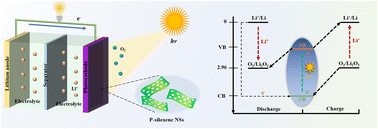Improving the rate performance is of great significance to achieve high-performance photo-assisted Li–O2 batteries for developing new optimized bifunctional photocatalysts. Herein, a holey etching strategy is developed to prepare porous siloxene nanosheets with a size of 10 nm and few layers (P-siloxene NSs) by a modified Ag+-assisted chemical etching method, and the optimized pore-forming conditions are: Ag+ ion concentration 0.01 mol dm−3, HF concentration 0.565 mol dm−3, and H2O2 concentration 0.327 mol dm−3. By using P-siloxene NSs with a bandgap of 2.77 eV as a novel bifunctional photo-assisted Li–O2 system, the rate performance of the assembled P-siloxene NSs photo-assisted Li–O2 batteries is clearly improved. At a current density of 0.1 mA cm−2, the system shows a low overpotential of 0.35 V, full discharge capacity of 3270 mA h g−1, and 69% round-trip efficiency at 100 cycles. In particular, at a current density of 0.8 mA cm−2, the P-siloxene NSs photo-assisted Li–O2 batteries still give a relatively good charge potential of 3.66 V and a discharge potential of 2.97 V. This work provides a new approach for improving the rate performance of photo-assisted Li–O2 systems and will open up opportunities for the high-efficiency utilization of solar energy in electric systems.
